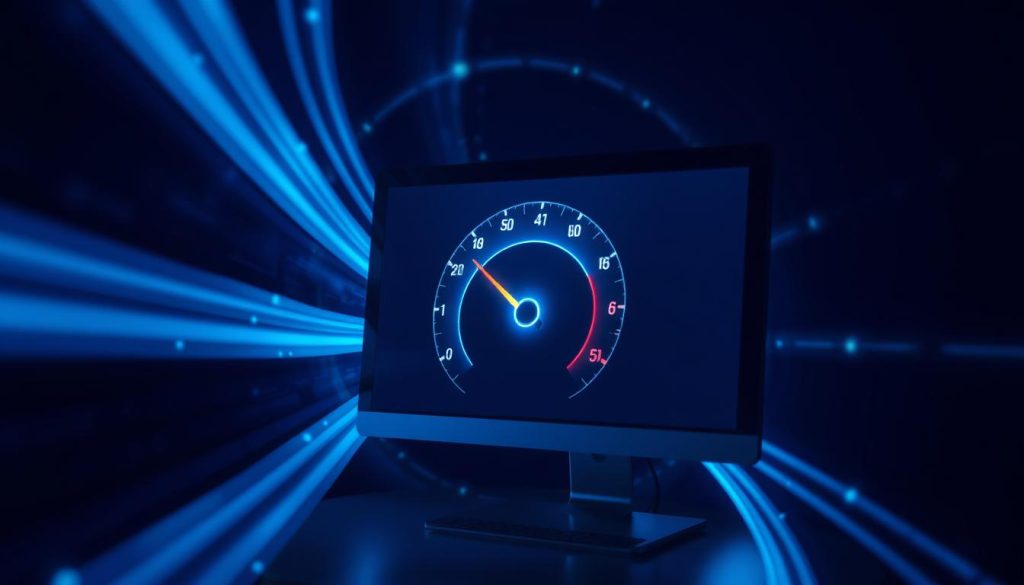As a website owner, I know how key page speed is. Google says it’s a big deal for search rankings. A slow site hurts user experience and rankings. Google notes that a 5-second load time can make 90% of users leave.
Improving page speed is vital for a better site and user experience. With the right tools, I can boost my site’s rankings and keep users engaged. Google suggests aiming for “Good” page speed scores for better rankings.
To speed up your site, focus on key areas. Optimize images, minify code, and use a Content Delivery Network (CDN). These steps can make your site faster and more enjoyable for users.
Key Takeaways
- Page speed is a crucial factor in determining search engine rankings
- A slow website can negatively impact user experience and search engine rankings
- Page speed optimization is essential to improve website speed and provide a better user experience
- Google recommends that web pages meet “Good” thresholds for key page speed metrics to improve search rankings
- Techniques such as image optimization, minifying CSS, JavaScript, and HTML, and using a Content Delivery Network (CDN) can improve website speed
- Regular updates and optimizations can help maintain optimal page speed, improving both user experience and SEO outcomes
- Page speed optimization can help increase user engagement and improve search engine rankings
Understanding Page Speed and Its Importance
Page speed is how fast a website loads and becomes ready to use. Google says it’s a big deal for search rankings. A slow site can make users leave quickly, hurting sales.
Most shoppers won’t visit sites that load slowly. A study shows bounce rates jump to 32.3% if a site takes 6 seconds to load. This shows why making sites load faster is key.
Google has cared about page speed since 2010. In 2018, it said it matters even more for a good user experience. Almost 70% of shoppers say speed affects their buying decisions.
What is Page Speed?
Page speed measures how fast a website loads and works. It’s influenced by things like images, hosting, and scripts.
Why Page Speed Matters for SEO
Page speed is vital for SEO because it affects rankings. A fast site can get more visitors, while a slow one might not.
The User Experience Connection
A quick website makes users happy, leading to more sales and loyalty. Since 47% of shoppers expect sites to load in 2 seconds, speeding up is essential.
Key Metrics for Measuring Page Speed
To make your website faster, it’s key to know the main metrics for page speed. These metrics give insights into how users feel when they visit your site. They help spot where you can make things better.
Important metrics include First Contentful Paint (FCP), Time to Interactive (TTI), and Largest Contentful Paint (LCP). These are vital for seeing how users interact with your site. They help you find ways to make it better.
First Contentful Paint (FCP)
FCP shows how long it takes for the first content to appear. A quicker FCP means happier users and more chances to convert.
Time to Interactive (TTI)
TTI tells you when your site is ready for users to interact. A faster TTI means users are happier and less likely to leave.
Largest Contentful Paint (LCP)
LCP measures when the biggest part of your content loads. A quicker LCP means users are more engaged and likely to convert.
By focusing on these key metrics, you can make your website faster and better for users. This can lead to more engagement, more conversions, and more money.
| Metric | Description |
|---|---|
| FCP | Measures the time from page load initiation to the display of the first piece of content |
| TTI | Measures the time it takes for a website to become interactive |
| LCP | Measures the time it takes for the largest content element to load |
Tools I Use for Page Speed Analysis
To make your website faster, you need the right tools. A website speed test can show you where to improve. Tools like Google PageSpeed Insights, GTmetrix, and Pingdom are great for this.
These tools give you insights into how fast your website is. For instance, Google PageSpeed Insights scores your site out of 100. Scores under 60 are considered poor, while scores over 90 are good.
- Google PageSpeed Insights: provides separate scores for mobile and desktop versions of a website
- GTmetrix: allows users to test website performance from multiple geographic locations
- Pingdom: provides instant URL tests and detailed recommendations
Using these tools can make your website faster and better for users. A quick website can also boost profits and sales. So, do a website speed test and use the results to speed up your site.
| Tool | Features |
|---|---|
| Google PageSpeed Insights | Separate scores for mobile and desktop, Core Web Vitals metrics |
| GTmetrix | Multiple geographic locations, detailed recommendations |
| Pingdom | Instant URL tests, detailed recommendations |
Common Factors Affecting Page Speed
Page speed optimization is key for website performance and search engine rankings. To improve page load time, it’s important to tackle several factors. These include image optimization, hosting environment, and managing JavaScript and CSS.
High-resolution images can slow down page loads. Using WebP file formats can speed up image loading without losing quality. Also, tools like WP Smush can compress images, reducing file sizes by about 14.2%. This makes pages load faster and improves user experience.
Hosting environment and managing JavaScript and CSS are also crucial. Upgrading to premium hosting can make pages load quicker. Minifying code also helps by reducing code size and speeding up sites. By focusing on these areas, website owners can enhance page speed, lower bounce rates, and boost user engagement. This leads to better search engine rankings and a stronger online presence.
Improving page speed involves several strategies:
- Optimizing images through compression and effective file formats
- Upgrading to premium hosting for improved load speeds
- Minifying code to reduce code bloat and improve site speed
By using these strategies, website owners can increase page load times. This improves overall page speed, leading to a better user experience and higher search engine rankings.
Implementing Image Optimization Techniques
Image optimization is key to faster page loading. It involves choosing the right file formats and compressing images. This way, images don’t slow down your website. Since images make up 64% of a website’s size, optimizing them is crucial.
Optimizing images means making them smaller without losing quality. Using JPEG for colorful images and PNG for simple ones helps. This way, your images are smaller but still look great.
- Choosing the right file formats, such as JPEG, PNG, or WebP
- Compressing images without quality loss using tools like Kraken or Optimizilla
- Using responsive images to ensure proper sizing for different devices
- Eliminating unnecessary metadata to reduce file sizes
By optimizing images, websites can load faster and keep visitors longer. Google PageSpeed Insights helps find and fix image issues. It’s a big help in making your website run smoothly.
Enhancing Server Response Time
Server response time is key for fast websites. Choosing the right hosting and using a content delivery network (CDN) helps a lot. Google says the best time is 100 milliseconds or less. Anything under 200 milliseconds is very good.
To get the best server response, use solid-state drives (SSDs) for faster speeds. Also, set up a “Keep-Alive” feature and use caching tools. A CDN with over 60 servers worldwide can also help a lot.

- Selecting a hosting plan that meets the website’s needs
- Utilizing a CDN to deliver content from geographically closer servers
- Optimizing database performance to reduce unnecessary data
- Implementing GZIP compression to reduce file sizes
By using these methods, websites can load faster. This means happier users and lower bounce rates. Google suggests aiming for a Time to First Byte (TTFB) under 200 milliseconds. Following these tips can help achieve this and boost your website’s speed.
Minifying CSS, JavaScript, and HTML
Minifying code is key to making websites faster. It involves removing unused code and making files smaller. This makes websites load quicker.
HTML, CSS, and JavaScript files can be quite big. Minifying them can cut their size by 20% to 50%. This means websites can load faster, making users happier. A 1-second delay can cost 7% in sales, studies show.
Tools like HTMLMinifier, CSSNano, and UglifyJS help minify code. They save time and ensure files are optimized. The PageSpeed Module for servers like Apache or Nginx can also automate this process.
Minifying code has many benefits:
- Improved page speed
- Increased user satisfaction
- Reduced bandwidth usage
- Faster content delivery through a Content Delivery Network (CDN)
By minifying CSS and JavaScript, websites use less bandwidth. This can lower CDN costs. PageSpeed Insights says not minifying can slow down websites by 2.47 seconds for CSS and 2.4 seconds for JavaScript. Minifying is a smart move for faster websites and happier users.
Reducing Server Redirects
Server redirects can slow down your website and hurt your search rankings. Understanding and cutting down on redirects can make your site faster. It’s key for a smooth user experience and quicker page loads.
Knowing about different redirects is crucial. 301 Redirects are good for SEO and last long. 302 Redirects are for short-term changes or promotions. Redirect chains, where you follow a series of URLs, slow things down.
To cut down on redirect chains, you can:
- Use 301 Redirects for permanent changes
- Stay away from Meta refresh redirects for better user experience
- Check and update your redirects often to avoid old ones
By reducing server redirects and shortening redirect chains, you can make your site faster. This also improves user experience and boosts your search rankings.
| Redirect Type | Description | Impact on Page Speed |
|---|---|---|
| 301 Redirect | Permanent redirect | Minimal impact |
| 302 Redirect | Temporary redirect | Some impact |
| Meta Refresh Redirect | Poor user experience | Significant impact |
By using these tips and reducing redirect chains, you can make your website load faster. This will also help your search rankings.
Leveraging Browser Caching
As I work on making my website faster, I’ve learned how key leveraging browser caching is. It helps users and search engines by storing often-used items in their browsers. This cuts down on server requests, making pages load quicker and saving bandwidth.
Setting up cache-control headers is a big part of using browser caching. It tells browsers how long to keep resources before they need to check back with the server. For static stuff, a week is a good start, but up to a year is even better.
Browser caching has many perks:
- It makes pages load faster, which means more people stick around and do more.
- It also makes your server work less hard, keeping your site stable even when lots of people visit.
- And it saves bandwidth, which can cut down on hosting costs if your site gets a lot of visitors.
Tools like Google PageSpeed Insights and GTmetrix help see how well browser caching is working. By tweaking browser caching and cache-control headers, I can make my site load much faster. This makes for a better experience for everyone who visits.

| Resource Type | Cache Duration |
|---|---|
| Images | 1 year |
| Stylesheets | 1 month |
| JavaScript files | 1 month |
Implementing Lazy Loading
Lazy loading makes your website faster by loading content only when it’s needed. This can cut down initial page load time by up to 50%. It does this by not loading images and videos until they’re visible.
By using lazy loading, you can make your website load faster. This leads to a better user experience. It also means more people will stay on your site and engage with it.
Lazy loading can also boost your PageSpeed Insights scores by 20% to 30%. This is because it loads less data, making pages load quicker. Plus, it saves server bandwidth by about 20% to 40% since only visible content is loaded.
Benefits of Lazy Loading
Lazy loading offers many advantages:
- Reduces initial page load time by up to 50%
- Boosts PageSpeed Insights scores by up to 30%
- Saves server bandwidth by up to 40%
- Improves user experience and engagement
- Increases conversions and sales
How to Enable Lazy Loading on My Site
To add lazy loading to your site, use the loading attribute in HTML. This attribute tells when an image or video should load. For instance, you can use loading=”lazy” to load an image when it’s visible.
Lazy loading can make your website faster and more enjoyable. It leads to more engagement and sales. With the right strategy, lazy loading can be a key to better website performance.
Regularly Monitoring Page Speed
It’s key to keep an eye on page speed to spot where you can get better. Using tools for page speed analysis helps make sure your site loads fast. This keeps your website running smoothly.
Just a one-second delay can cut page views by 11%. If your site takes 3 seconds to load, 32% more people will leave. So, it’s important to watch your page speed closely and do page speed analysis often.
Some important facts to remember when monitoring page speed are:
- 53% of mobile users will leave if your site takes over 3 seconds to load.
- Websites that load in 5 seconds are 90% more likely to be bounced than those that load in 3 seconds.
- Using caching can cut page load times by up to 70%.
By keeping up with page speed and doing page speed analysis, you can find ways to make your site better. This leads to a better user experience and more sales.
Creating a Page Speed Optimization Checklist
As we finish this detailed guide on speeding up your website, it’s crucial to make a checklist. This ensures your efforts to improve page speed stay effective.
Keeping your site fast is a continuous task. A checklist helps you tackle problems early and keeps your website running smoothly.
Essential Steps for Optimization
Begin by doing regular page speed checks with tools like Google PageSpeed Insights, GTmetrix, and Pingdom. Look for areas to improve, such as optimizing images, reducing server response times, and minifying code. Then, apply fixes and watch how they affect your site’s performance.
Maintaining Your Site’s Speed Over Time
Make page speed optimization a regular part of your website care. Check your content, images, and code often to make sure they load quickly. Always keep an eye on how your site is doing and fix any problems quickly. This way, you’ll keep your website fast and your visitors happy.
FAQ
What is page speed?
Why does page speed matter for SEO?
How does page speed impact user experience?
What are the key metrics for measuring page speed?
What tools can I use for page speed analysis?
What are some common factors that can affect page speed?
How can I implement image optimization techniques?
How can I enhance server response time?
What are the benefits of minifying code?
How can I reduce server redirects?
What is the importance of leveraging browser caching?
How can I implement lazy loading?
Why is regularly monitoring page speed important?
What should I include in a page speed optimization checklist?
Source Links
- Page speed optimization: Everything you need to know – https://searchengineland.com/page-speed-optimization-guide-448321
- What Is Page Speed & How to Improve It – https://www.semrush.com/blog/page-speed/
- Page Speed: How to evaluate and improve page speed – https://moz.com/learn/seo/page-speed
- What is Page Speed? [+Why It’s Important for SEO] – https://edgemesh.com/blog/page-speed
- What is page speed? | Uptrends – https://www.uptrends.com/what-is/page-speed
- The Importance of Page Speed in Search Engine Optimization | Flowmatters – https://www.flowmatters.com/blog/the-importance-of-page-speed-in-search-engine-optimization/
- 13 Metrics to Measure Website Performance in 2024 – https://nitropack.io/blog/post/website-performance-metrics
- Top 3 Site Speed Metrics To Boost Performance and Conversion Rates – https://www.webfx.com/blog/marketing/site-speed-metrics/
- 17 Best Website Speed Test Tools In 2025 – https://www.authorityhacker.com/best-website-speed-test-tools/
- 26 Tools for Improving Your Website’s Page Speed – https://www.webfx.com/blog/marketing/26-tools-improve-page-speed/
- How important is page speed for SEO in 2023? – https://www.edgeoftheweb.co.uk/blog/importance-of-page-speed
- Page Speed and SEO: The Complete Guide – https://backlinko.com/hub/seo/pagespeed
- How to Optimize Images to Speed Up Your Website – https://loadninja.com/articles/optimize-images/
- Optimize Images | PageSpeed Insights | Google for Developers – https://developers.google.com/speed/docs/insights/OptimizeImages
- How to Optimize Images for Page Speed (and Google) – https://imagify.io/blog/optimize-images-page-speed-google/
- 10 Ways to Reduce Initial Server Response Time on Your Site – https://nitropack.io/blog/post/reduce-initial-server-response-time
- Ways to Reduce Initial Server Response Time – https://wpengine.com/resources/reduce-server-response-time/
- How to Reduce Time to First Byte (TTFB) and Server Response Times on WordPress – https://wp-rocket.me/google-core-web-vitals-wordpress/reduce-ttfb-server-response-times/
- Minify Resources (HTML, CSS, and JavaScript) | PageSpeed Insights | Google for Developers – https://developers.google.com/speed/docs/insights/MinifyResources
- How to Minify CSS and JavaScript in WordPress – https://wp-rocket.me/google-core-web-vitals-wordpress/minify-css-javascript/
- How to Minify CSS, JavaScript, and HTML for Speed – https://blog.pixelfreestudio.com/how-to-minify-css-javascript-and-html-for-speed/
- Redirects and How They Improve Web Performance? | Scaleflex Blog – https://blog.scaleflex.com/redirects-web-performance-best-practices/
- How to Reduce Redirects to Optimize Website Speed – https://www.setubridge.com/how-to-reduce-redirects-for-website-speed/?srsltid=AfmBOorS5Vfg3Bb04zUhrUpL2oZfikYotCSqigMzv0__-4QkMARpHfVz
- Leverage Browser Caching | PageSpeed Insights | Google for Developers – https://developers.google.com/speed/docs/insights/LeverageBrowserCaching
- Leverage Browser Caching: A Beginner’s Guide – Hike SEO – https://hikeseo.co/learn/onsite/technical/leverage-browser-caching/
- How to Improve Website Performance: Leverage Browser Caching – https://www.hostinger.com/tutorials/website/improving-website-performance-leveraging-browser-cache
- How to Lazy Load for Speed Optimization – https://onescales.com/blogs/main/lazy-load-speed-optimization
- Boost Your Website Speed With Lazy Loading: A Beginner’s Guide – https://fooplugins.com/benefits-of-lazy-loading/
- PageSpeed Optimization – PageFly Manual – https://help.pagefly.io/manual/pagespeed-optimization/
- The Importance of Page Speed and Performance Optimization in WordPress – https://www.nobledesktop.com/learn/wordpress/the-importance-of-page-speed-and-performance-optimization-in-wordpress
- Page Speed Optimization Service -Enhancing Website Performance – https://medium.com/@topgunseoteam/page-speed-optimization-service-enhancing-website-performance-21d8b86aa7ef
- PAGE SPEED OPTIMIZATION: BEST PRACTICES FOR WEBSITE SPEED AND SEO – https://www.linkedin.com/pulse/page-speed-optimization-best-practices-website-seo-tonmoy-das
- Page Speed Checklist – Website Performance Optimization – https://pagespeedchecklist.com/
- Accelerate Your Page Speed: Site Speed & Performance Checklist – https://www.webfx.com/blog/marketing/speed-site-speed-performance-checklist/


